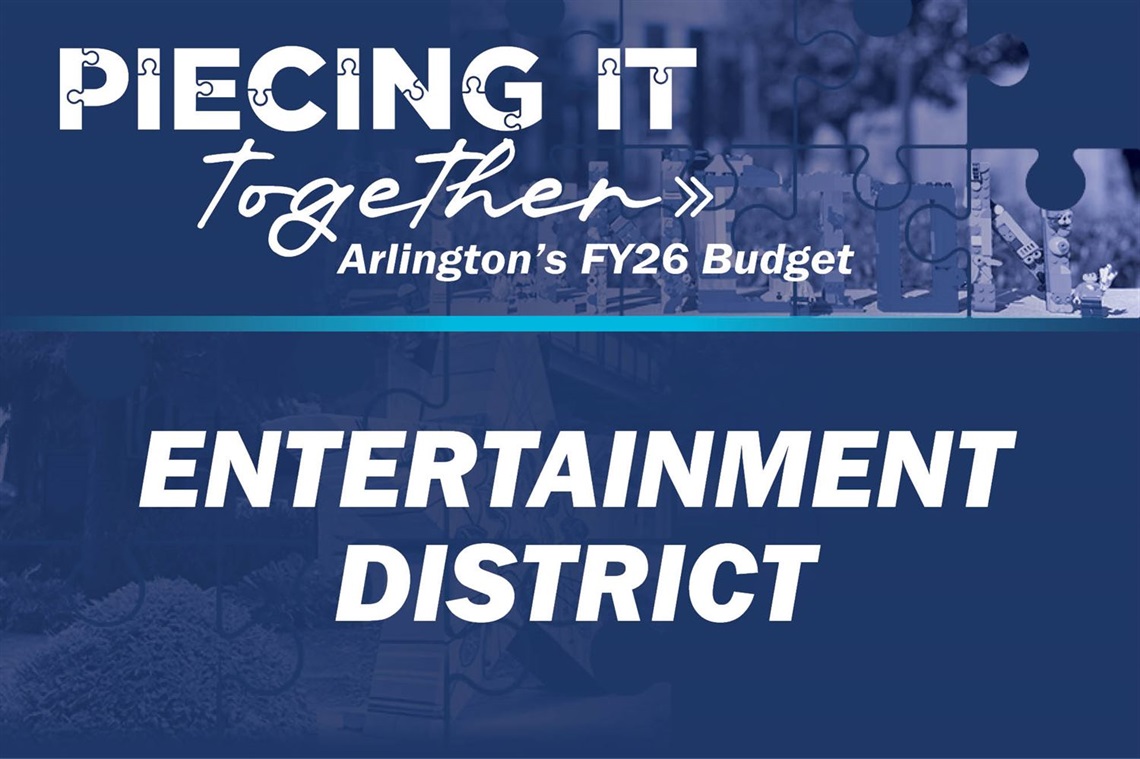How Entertainment District Growth Helps City Provide Core Services
Published on June 18, 2025

The City of Arlington is facing a challenging Fiscal Year 2026. Throughout the next several months, our “Piecing it Together” budget series will provide a high-level overview of the unique situational and economic factors impacting Arlington’s budget this year. Have a question or topic you’d like to see included? Send us a message.
Just weeks before Arlington residents voted to approve the Cowboys Stadium deal in November 2004, then-City Manager Chuck Kiefer found himself navigating significant budget challenges for the year ahead.
In an economic time much like what we are seeing today, Arlington’s revenue growth was not keeping up with residents’ demands for service in Fiscal Year 2005.
The year before, the City raised the property tax rate by 1.4 cents and cut $13.7 million in programs and services to balance the FY04 budget. But while Arlington’s sales tax collections had begun recovering after two years of steep declines, Kiefer noted the single-digit growth was concerning.
“Many of our neighboring cities have seen double digit increases,” he wrote. “It is impossible to predict that sales taxes will ever return to the growth rates the City experienced during the 1990s.”
But like Mark Teixeira’s homerun streak with the Rangers in 2005, Arlington began to consistently hit it out of the park with sales tax revenue for the next 20 years. With exception to FY20 during the COVID-19 pandemic, the City’s sales tax revenues have steadily grown, nearly doubling from $48.8 million in 2005 to an estimated $97 million in 2025. That money goes directly to the City’s General Fund, which supports core services such as police and fire, parks and recreation, libraries, and city administration.
Several factors have contributed to that growth over the past two decades. These include Arlington’s population increased by 16%, major retailers, such as the Arlington Highlands shopping center and Summit Racing Equipment, opening, and state law changes requiring online sellers to remit sales and use tax to cities. The Entertainment District, which is home to venues such as AT&T Stadium, Globe Life Field, Six Flags Over Texas and Hurricane Harbor and the National Medal of Honor Museum, also plays a role. As a major tourist destination centrally located in the country, more than 15 million visitors come to eat, shop and stay here each year.
Why is Arlington facing a budget shortfall if we have the Entertainment District? Where does tax revenue from visitors go?
Arlington has a broad and diverse sales tax base, with tourism being just one part of it. Tourism dollars supplement overall sales tax revenues, which helps the City provide high-quality services and keep the property tax rates low the past two decades.
But tourism revenue alone is not enough to offset significant budget challenges Arlington faces in the current FY25 and in FY26.
To balance this fiscal year’s budget, the City raised the property tax rate for the first time in 20 years and implemented $5.8 million in spending cuts. City leaders are currently working to close a projected $25 million shortfall in the FY26 General Fund, largely due to factors like slower property value growth, lower-than-expected sales tax receipts, and modified appraisal district processes.
Arlington has a diverse sales tax base, but without the Entertainment District and tourism, the City’s current financial challenges would be worse. City data shows that milestone events in Entertainment District, such as the opening of AT&T Stadium in 2009, Texas Live! in 2018, Globe Life Field in 2020 and the new Arlington Convention Center in 2024, are consistently followed by periods of increased sales tax and hotel occupancy tax collections.
Each year, Arlington put those sales tax dollars to work for residents across the 99-square-mile city. Since 2009, which is when AT&T Stadium opened, Arlington has:
- Added 91 sworn police positions
- Added 172 sworn fire positions
- Opened Fire Station No. 17 in north Arlington
- Opened the George W. Hawkes Downtown Library
- Opened the Beacon Recreation Center, East Library and Recreation Center and ACTIV
- Constructed 65.56 new lanes miles of roadway
- Maintained 3,018 lane miles of roadway
Tourists also contribute millions of dollars each year to the City’s Convention and Event Services Fund through hotel occupancy fees, parking fees and other expenses, such as Convention Center meeting space rentals and catering. The City is limited by state law on how these funds are used. Hotel occupancy taxes can be used to promote tourism, arts and the hotel industry, for example, but not general expenses such as police and firefighter salaries or to buy library materials.
Arlington residents benefit from investments the City is able to make in arts and historic preservation initiatives thanks to visitor spending. Since 2022, Arlington has awarded $2.1 million in Arlington Cultural Tourism Council grants, funded by hotel occupancy taxes, to support Downtown arts and cultural programming. These grants have been awarded to venues such as Levitt Pavilion Arlington, Symphony Arlington, Arlington Music Hall, Dance Theatre Arlington, and Theatre Arlington.
In summary, the Entertainment District does provide a boost to Arlington’s overall economy, its reputation as a tourism destination, and the City’s ability to raise revenue to provide essential services and support arts and culture. But the financial impact of individual events in the Entertainment District, while welcomed, is not to offset the loss of other revenue sources to the General Fund that Arlington is currently experiencing.